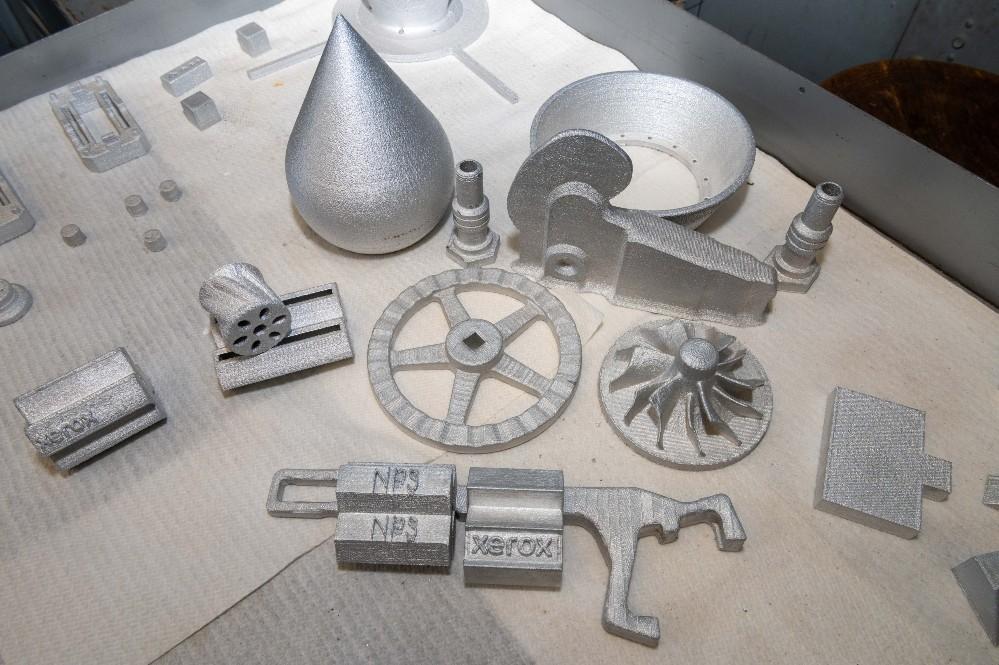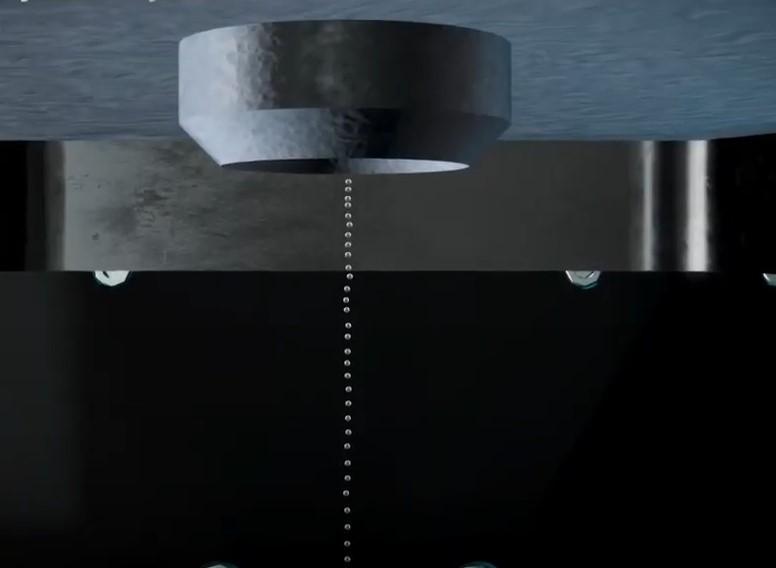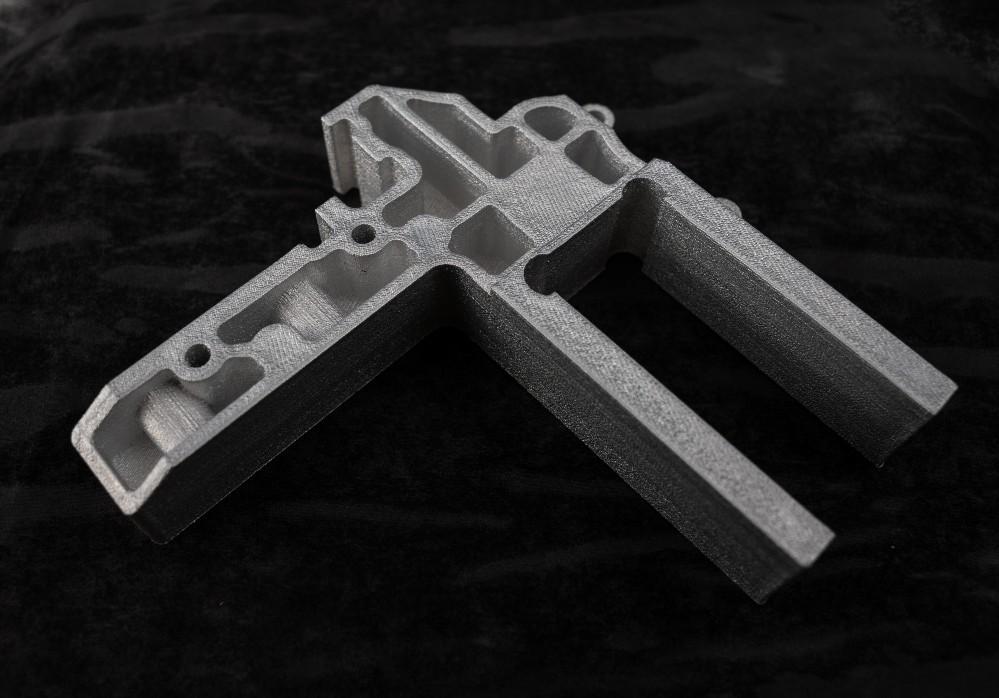- FMA
- The Fabricator
- FABTECH
- Canadian Metalworking
Our Publications
Categories
- Additive Manufacturing
- Aluminum Welding
- Arc Welding
- Assembly and Joining
- Automation and Robotics
- Bending and Forming
- Consumables
- Cutting and Weld Prep
- Electric Vehicles
- En Español
- Finishing
- Hydroforming
- Laser Cutting
- Laser Welding
- Machining
- Manufacturing Software
- Materials Handling
- Metals/Materials
- Oxyfuel Cutting
- Plasma Cutting
- Power Tools
- Punching and Other Holemaking
- Roll Forming
- Safety
- Sawing
- Shearing
- Shop Management
- Testing and Measuring
- Tube and Pipe Fabrication
- Tube and Pipe Production
- Waterjet Cutting
Industry Directory
Webcasts
Podcasts
FAB 40
Advertise
Subscribe
Account Login
Search
The first Xerox 3D printer lands at a California Navy college
The ElemX metal printer builds parts from aluminum wire
- By Holly B. Martin
- Updated January 24, 2023
- August 2, 2021
- Article
- Additive Manufacturing

The Naval Postgraduate School was the first organization to take delivery of a Xerox ElemX liquid metal 3D printer. Xerox
Xerox announced in 2019 that it was moving into the additive manufacturing space. The first AM product from the global corporation known for its inkjet printer and document management systems is the ElemX liquid metal 3D printer.
The printer, initially developed by startup Vader Systems, builds parts from standard aluminum wire. Xerox acquired Vader in 2019, then spent the next year refining and hardening the technology.
“Since we acquired Vader Systems, Xerox has improved and refined the process and increased the build rate, cycle time, feature resolution, and surface quality of prints significantly, and we’ve added two new aluminum materials to our wheelhouse,” said Matthew Sozio, a member of Xerox’s AM team tasked with business development and strategy. “We’ve really extended the palette of this technology.”
The first commercial ElemX was installed in December 2020 at the Naval Postgraduate School, Monterey, Calif.
Jetting Liquid Metal
According to Sozio, ElemX technology is similar to that of a polymer-filament 3D printer. “The concept is simple. You take a wire, melt it, and then jet it—drop by drop and layer by layer—onto a heated build plate.
“At Xerox, our core knowledge stems from inkjet printing, so we know how to deposit a lot of jetted material at scale, very precisely, and essentially that’s what we’re doing with this liquid metal technology. The real challenge is how to control each of those individual drops and how they coalesce,” Sozio said.
The ElemX printhead relies on magnetohydrodynamics, the science of electrically charging liquids such as molten aluminum and using a magnetic force to move them. After the wire melts, electromagnetic pulses around the outside of the aluminum melt pool “squeeze” the pulses back and forth and individual drops of molten metal exit the nozzle at the rate of hundreds of drops per second.
“By changing the materials used for printhead nozzles and pumps, we’ve extended jetting stability to last well over eight hours a shift, and we also integrated safety and environmental controls, which Xerox knows well from our 2D business,” Sozio said.
Using the Xerox 3D Printer Internally
In a real-life demonstration of ElemX’s applicability in a manufacturing setting, Xerox used the printer to build replacement parts after a key supplier went out of business. The machine 3D-printed aluminum 4008 replacement brackets for the company’s line of iGen 5 digital printing presses.
The company felt it had two choices: Estimate the number of brackets needed for the rest of the iGen’s life and purchase those up front, or look for and qualify a new supplier. The former would mean a significant cash outlay and long-term storage of parts, and the latter would require moving the tool and requalifying the part.

Shown are aluminum parts the Naval Postgraduate School 3D-printed on the ElemX printer. Mass Communication Specialist Third Class Lenny Weston
“Neither of these options was ideal, so we said to the iGen team, ‘What if there were a third option?’ And that’s how we got involved with using the ElemX to 3D print the bracket,” said Tali Rosman, vice president and general manager of 3D printing at Xerox.
She added that Xerox has 500,000 unique parts in its repository, and with the ElemX and “our liquid metal roadmap, my goal is to be able to cater to more and more of these parts. It’s always a dual question of whether I can print it, technically, and should I print it from an economic perspective. And like everything else in 3D printing, it depends on the use case and the material properties that you need.”
Xerox 3D Printer's Naval Service
Additive manufacturing has the potential to transform how the military supplies its forward-deployed forces. Driven by this belief, the Naval Postgraduate School(NPS) and Xerox agreed to collaborate on advancing additive research, specifically 3D printing.
As part of a Cooperative Research and Development Agreement (CRADA), NPS took delivery of the first commercial ElemX. The school’s faculty and students have been using a Xerox ElemX liquid metal printer to conduct thesis research and seek new ways to extend the Navy’s and Marine Corps’ capabilities.
“With liquid metal printers like the ElemX, the Navy will be able to print parts onboard ship, so if you are in the middle of the ocean and you don’t have a spare part, you can make it relatively quickly,” said Dr. Amela Sadagic, research associate professor and co-director of the Center for Additive Manufacturing at NPS. “But we also are very much interested in the ability of sailors and marines to design and create new parts and tools that never existed.”
Since the printer arrived, the university has graduated two students who based their theses on research conducted with assistance from the ElemX. Both theses looked at printing hollow metal parts.
During the months since it was installed, Xerox has continued to update the printer on campus as new capabilities were developed. At the same time, as part of the CRADA, the students and professors provided invaluable feedback to Xerox.
“After observing student and faculty operators in action, we are reporting back to Xerox, highlighting areas where improvement in the user experience is needed,” said Sadagic.
“We are pushing the limits of this printer every day and keeping Xerox on their toes because our students are asking questions like, ‘What if? Why not? Could we do a certain type of print?’” said Dr. Garth Hobson, professor and chair of the Department of Mechanical and Aerospace Engineering at NPS.
He also cited some of the printer’s advantages, including a shorter printing time and less time needed to postprocess parts. “It takes literally minutes to have a part in your hand, versus other printers where it takes hours, or sometimes days, to get a part off the build plate,” Hobson said.

After the ElemX melts aluminum wire, electromagnetic pulses around the outside of the melt pool “squeeze” the pulses back and forth, and individual drops of molten metal exit the nozzle at the rate of hundreds of drops per second. Xerox
Printing Onboard Ship
Safety is a critical feature when 3D-printing objects aboard a confined ship at sea. The ElemX doesn’t use metal powders or lasers, which not only simplifies operation but reduces the danger of operating it.
As a continuation of their collaboration, Xerox and NPS are looking at the possibility of installing an ElemX printer onboard a surface ship. “We always intended to put this machine through a simulated sea state environment, but now we hope to leapfrog that requirement,” said Hobson. “We have, for the very first time, a liquid metal printer that’s going to operate under seagoing conditions, including motor vibrations; rolling waves; and a wide range of temperature, humidity, and air pressure.
“The data from those prints are going to be absolutely invaluable when we compare them with data from similar parts printed here in our lab,” said Hobson.
“For the last several years, we’ve been sending ships to sea with polymer 3D printers, but an aluminum metal printer will take it up a notch,” said U.S. Navy Capt. Dan Sunvold, surface warfare chair at NPS.
“By getting a liquid metal printer into the hands of the innovative sailors at sea, working on the same things that the faculty and students here at NPS are working on, they can collaborate and share in near real time the lessons learned,” said Sunvold. “I think that’s a huge win.”
On-Demand Parts for the Xerox 3D Printer
3D printing on-demand parts close to the point of consumption lowers inventory and warehousing and is a great vision. But to do that you need a technology that’s easy to implement, easy to use, and scalable.
Rosman said this is where ElemX technology “hits the mark,” because users don’t need a clean room, facility requirements are minimal, and the materials used aren’t hazardous. “It’s not plug and play, but it’s as close as you’re going to get with production grade for metal,” she said.
About the Author

Holly B. Martin
About the Publication
- Podcasting
- Podcast:
- The Fabricator Podcast
- Published:
- 04/16/2024
- Running Time:
- 63:29
In this episode of The Fabricator Podcast, Caleb Chamberlain, co-founder and CEO of OSH Cut, discusses his company’s...
- Trending Articles
- Industry Events
16th Annual Safety Conference
- April 30 - May 1, 2024
- Elgin,
Pipe and Tube Conference
- May 21 - 22, 2024
- Omaha, NE
World-Class Roll Forming Workshop
- June 5 - 6, 2024
- Louisville, KY
Advanced Laser Application Workshop
- June 25 - 27, 2024
- Novi, MI



























